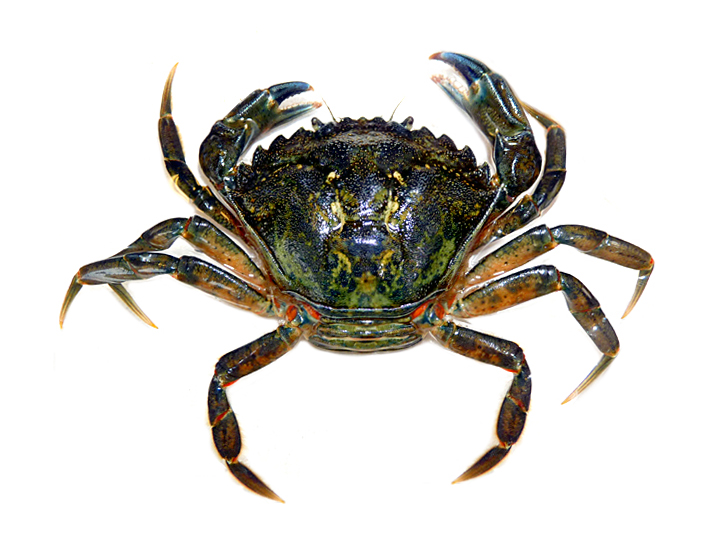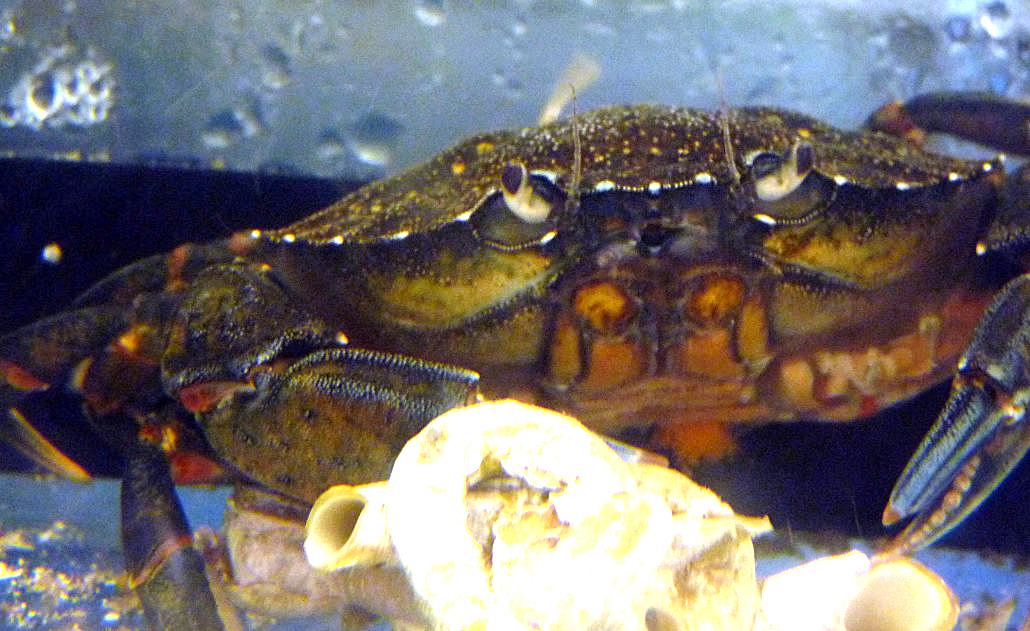European Green Crab
Authors: Lilly Powell and Emma Hornell
Scientific name: Carcinus maenas
Size Range: The European Green Crab is commonly between 60mm long and 90mm wide but has been noted to grow up to 101mm wide in non-native areas such as British Columbia.
Identifying Features: The European green crab is not always pure green, its dorsal shell being mottled dark green to brown with yellow patches on the ventral surface. However, the crab’s shell may change to orange or red during the molting cycle. Some of the most identifiable features of the Carcinus maenas are the array of five spines on either side of the eyes on the front end of the carapace, and three rounded bumps between its eyes.


Habitat: European Green Crabs are known to be one of the most invasive alien species to marine ecosystems. They are native in the Atlantic Ocean ranging from North Africa along the coast of Spain to the Baltic Sea and around Britain. It is believed they first came to North America in the 1800’s in the ballast water of large ships. They first became established on the west coast of North America in Central California near California. Though most invasive species in British Columbia are thought to come in ballast water of visiting ships it is thought the Green Crab most likely arrived as larvae that drifted on northern currents from the central California area. They can now be found from Central California all the way up to Southern British Columbia. Green Crabs are very adaptive and can tolerate a wide range of salinity (4-54 ppt) and temperatures (0-33°C). Green Crabs can be found in a variety of habitats in the intertidal zone such as: protected rocky shores, cobble beaches, sand flats, and tidal marshes.
Prey: The European Green Crab will feed on anything it can get its claws on, its most common prey being: clams, oysters, mussels, and other small native crabs. The crab is extremely dexterous, and has many ways to open the shellfish it eats.
Known Predators: In its native habitat Carcinus maenas’ predators include the Conger Eel, the Trigla Lucerna, Bass, and the Fivebeard Rockling. The crab’s defenses include its ability to rotate its claws over its back to defend against predators coming from behind, and being able to live outside of water in the sun for up to a week.
Reproduction & Life Cycle: European Green Crabs typically mate during the summer, when the female crab has just molted and is vulnerable. During this time, the male green crab guards the female by pairing with her in a “pre-molt cradling”, protecting her from other males and predators. The egg sac appears a few months after mating and is carried for several months. The eggs then hatch into free-swimming larvae that stay in the water for 17 to 80 days before settling to the bottom as tiny crabs. The European green crab lives for up to five years and reaches sexual maturity at two or three years.
Impacts: Known as The Most Invasive Crab in the World, the European Green Crab is a huge threat to our waters in the Pacific Northwest. Its floating larval stage contributes largely to its rapid migration and its feeding habits and environmental tolerance enables it to adapt to many places. Marine biologists believe the crab will also wipe out many commercial fisheries – it already has been discovered as a leading contributor to the dramatic declines in the soft-shell clam fishery (aided by its ability to consume over 40 small clams a day). It is also a threat to vital Eel-Grass habitats used by many small creatures. The crabs will snap the plants at their base, effectively preventing the grass from growing and reproducing, and will also damage the rhizomes of the plants when they are burrowing amongst them to look for prey or to hide.
Photos by D. Young

References:
Carcinus maenas – Details. (n.d.). Encyclopedia of Life. Retrieved January 22, 2014, from http://eol.org/pages/128502/details
Conservancy of Canada (NCC). (n.d.). European green crab. NCC:. Retrieved January 22, 2014, from http://www.natureconservancy.ca/en/what-we-do/resource-centre/invasive-species/european_green_crab.html
Department of Fish & Wildlife. (n.d.). European Green crab (Carcinus maenas) – Aquatic Invasive Species . Washington Department of Fish & Wildlife. Retrieved January 19, 2014, from http://wdfw.wa.gov/ais/carcinus_maenas/
Lamb, A and Hanby, B.P. (2005) Marine Life of the Pacific Northwest: A photographic encyclopaedia of invertebrates, seaweeds and select fishes. Madeira Park, B.C. : Harbour Publishing
Ross, I. (2007, October). Sault is bug-eyed for invasive species lab. Northern Ontario Business, 27(12), 8. Retrieved January 22, 2014 from http://go.galegroup.com/ps/i.do?id=GALE%7CA170116367&v=2.1&u=61vhss&it=r&p=CPI&sw=w&asid=472df8f18415a9c172a1265c593865f5
